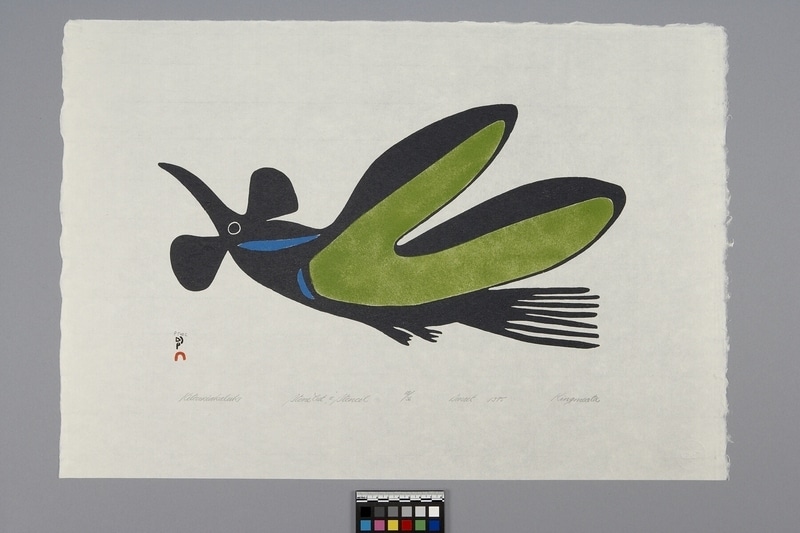Kitauriakaluk Item Number: Na810 from the MOA: University of British Columbia

Description
Stylized mosquito has extended wings, proboscis, one eye, legs and tail. Below image in pencil from side on left: "Kitouriakaluk stonecut and stencil 18/50 Dorset 1975 Kingmeata." Canadian Eskimo Arts Council's blind embossed stamp at lower edge on right. Artist's name stamped in Inuit syllabics next to Cape Dorset Co-operative seal of stylized ''red igloo'' in lower corner on left.
History Of Use
Contemporary Inuit prints were first produced at Cape Dorset in 1957. Although precursors to printmaking can be seen in women's skin applique work and in men's incising of ivory, stone and bone, the impetus for printmaking was as a commercial venture. This venture was established jointly by Inuit artists and John Houston, the civil administrator for Cape Dorset. Other Inuit communities quickly followed the commercial success of Cape Dorset's West Baffin Eskimo Cooperative. Printmaking developed as a communal activity following a Japanese, rather than a Western, model of serigraph production. Each year the cooperatives produce a series of limited edition prints which are sold in the retail art market. In 1965, the Canadian Eskimo Arts Council was established from the Canadian Eskimo Art Committee to ensure high standards were maintained. Printmaking, along with stone carving, provide cash income for communities which have undergone rapid and significant change, during the late 20th century, from traditional hunting based societies to settled communities dependent on consumer goods. The prevalent images depicted in Inuit art are of traditional life, arctic animals and mythology. Recently, contemporary subjects have been depicted by a minority of artists.
Cultural Context
contemporary art
Item History
- Made by Kingmeata Etidlooie (Maker) in Cape Dorset, Nunavut, Canada and Kinngait, Nunavut, Canada during 1975
- Collected before 1983
- Owned by Guenter Adolphs before December 15, 1983
- Received from Guenter Adolphs (Donor) on December 15, 1983
What
- Name
- Kitauriakaluk
- Identification Number
- Na810
- Type of Item
- Manufacturing Technique
- printed, stencilled and stonecut
- Overall
- height 17.1 in, width 25.0 in
Who
- Culture
- Inuit
- Creator
- Kingmeata Etidlooie (Maker)
- Previous Owner
- Guenter Adolphs
- Received from
- Guenter Adolphs (Donor)
Where
- Holding Institution
- MOA: University of British Columbia
- Made in
- Cape Dorset, Nunavut, Canada and Kinngait, Nunavut, Canada
When
- Creation Date
- during 1975
- Collection Date
- before 1983
- Ownership Date
- before December 15, 1983
- Acquisition Date
- on December 15, 1983
Other
- Item Classes
- works on paper
- Condition
- good
- Accession Number
- 0914/0080